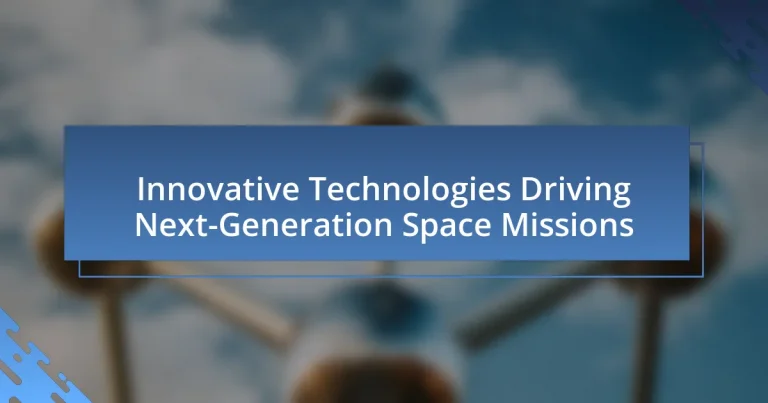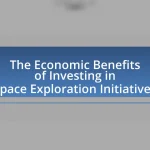Innovative technologies are transforming next-generation space missions, with advancements in propulsion systems, artificial intelligence, and autonomous robotics leading the way. These technologies enhance exploration capabilities by improving data collection, navigation, and communication, while also addressing challenges such as mission safety and efficiency. Key developments include electric propulsion systems, autonomous spacecraft operations, and in-situ resource utilization technologies, all of which are being implemented in current missions like NASA’s Perseverance rover and the European Space Agency’s JUICE mission. The article will explore the implications of these innovations for future missions, the challenges faced, and best practices for integrating new technologies in space exploration.
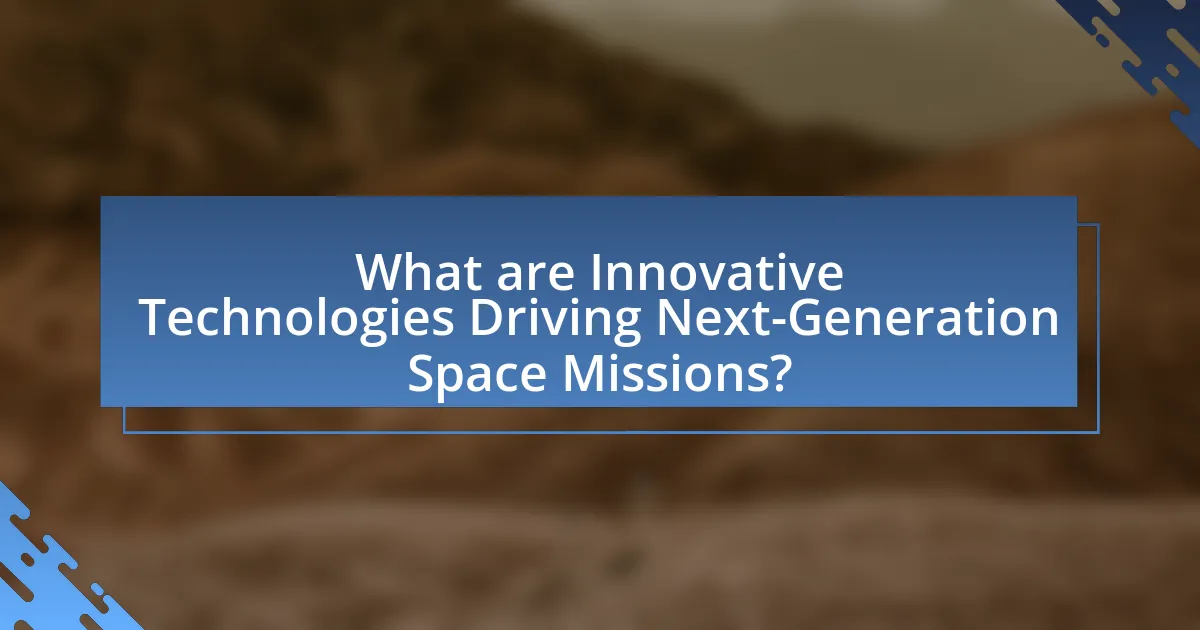
What are Innovative Technologies Driving Next-Generation Space Missions?
Innovative technologies driving next-generation space missions include advanced propulsion systems, artificial intelligence, and autonomous robotics. Advanced propulsion systems, such as ion thrusters and solar sails, enable spacecraft to travel faster and more efficiently, reducing mission times and costs. Artificial intelligence enhances data analysis and decision-making processes, allowing for real-time adjustments during missions. Autonomous robotics, including rovers and drones, facilitate exploration and data collection on planetary surfaces without direct human intervention. These technologies are validated by successful missions like NASA’s Perseverance rover, which utilizes AI for navigation and decision-making, and the European Space Agency’s BepiColombo mission, employing advanced propulsion techniques for its journey to Mercury.
How do these technologies enhance space exploration capabilities?
Innovative technologies enhance space exploration capabilities by improving data collection, navigation, and communication. For instance, advancements in artificial intelligence enable autonomous decision-making for spacecraft, allowing them to adapt to unforeseen circumstances during missions. Additionally, enhanced propulsion systems, such as ion thrusters, provide greater efficiency and longer mission durations, enabling deeper space exploration. Furthermore, improved satellite communication technologies facilitate real-time data transmission, which is crucial for mission success and safety. These technologies collectively increase the effectiveness and reach of space missions, as evidenced by NASA’s Mars Perseverance Rover, which utilizes AI for navigation and data analysis, significantly enhancing its operational capabilities on the Martian surface.
What specific technologies are being developed for future missions?
Specific technologies being developed for future missions include advanced propulsion systems, autonomous robotics, and in-situ resource utilization (ISRU) technologies. Advanced propulsion systems, such as ion thrusters and solar sails, aim to enhance spacecraft efficiency and reduce travel time to distant destinations. Autonomous robotics are being designed to perform tasks on planetary surfaces, enabling exploration without direct human intervention. ISRU technologies focus on utilizing local resources, such as extracting water from lunar regolith, to support long-term human presence in space. These developments are supported by ongoing research and testing by organizations like NASA and private aerospace companies, which emphasize the need for sustainable and efficient exploration methods.
How do these technologies improve mission safety and efficiency?
Innovative technologies enhance mission safety and efficiency by integrating advanced data analytics, automation, and real-time monitoring systems. These technologies enable precise navigation and decision-making, reducing the risk of human error and improving response times during critical operations. For instance, autonomous spacecraft equipped with AI can analyze vast amounts of data to identify potential hazards, allowing for timely adjustments to mission parameters. Additionally, real-time telemetry systems provide continuous monitoring of spacecraft health, ensuring that any anomalies are detected and addressed promptly, thereby minimizing the likelihood of mission failure.
Why is innovation crucial for the future of space missions?
Innovation is crucial for the future of space missions because it enables the development of advanced technologies that enhance mission capabilities and reduce costs. For instance, innovations in propulsion systems, such as ion thrusters, allow spacecraft to travel further and more efficiently than traditional chemical rockets. Additionally, advancements in materials science lead to lighter and more durable spacecraft, improving their performance and longevity. The successful Mars Rover missions, which utilized cutting-edge robotics and AI for navigation and data collection, exemplify how innovation directly contributes to mission success and scientific discovery.
What challenges in space exploration necessitate innovative solutions?
Challenges in space exploration that necessitate innovative solutions include the harsh environmental conditions of space, the need for sustainable life support systems, and the limitations of current propulsion technologies. The extreme temperatures, radiation, and microgravity conditions pose significant risks to human health and equipment functionality, requiring advancements in protective materials and habitat designs. Additionally, sustainable life support systems are essential for long-duration missions, as evidenced by the International Space Station’s reliance on recycling systems for air and water. Current propulsion technologies, such as chemical rockets, limit the speed and efficiency of space travel, highlighting the need for innovative propulsion methods like ion drives or nuclear thermal propulsion to enable deeper space exploration.
How does innovation impact the cost and sustainability of space missions?
Innovation significantly reduces the cost and enhances the sustainability of space missions by introducing advanced technologies and efficient processes. For instance, the development of reusable rocket systems, such as SpaceX’s Falcon 9, has decreased launch costs by approximately 30% to 50% per mission compared to traditional expendable rockets. Additionally, innovations in materials science, like lightweight composites and 3D printing, allow for more efficient spacecraft designs, which further lower costs and resource consumption. These advancements not only make missions more economically viable but also promote sustainability by minimizing waste and reducing the environmental impact associated with space exploration.
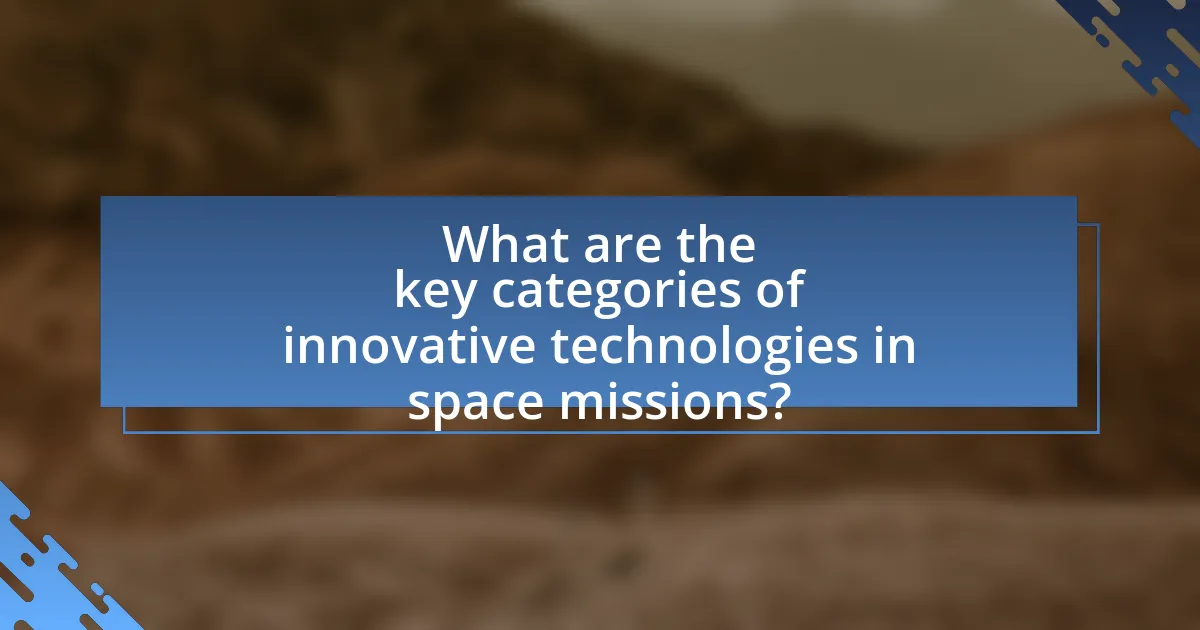
What are the key categories of innovative technologies in space missions?
The key categories of innovative technologies in space missions include propulsion systems, communication technologies, robotics and automation, materials science, and data analytics. Propulsion systems, such as ion thrusters and solar sails, enhance efficiency and reduce travel time. Communication technologies, including laser communication and advanced antennas, improve data transmission rates and reliability. Robotics and automation enable autonomous operations and maintenance of spacecraft, while advancements in materials science lead to lighter and more durable spacecraft components. Data analytics, powered by artificial intelligence, enhances mission planning and real-time decision-making. These categories collectively drive the efficiency, safety, and effectiveness of modern space missions.
How do propulsion systems contribute to next-generation missions?
Propulsion systems significantly enhance next-generation missions by enabling faster travel, increased payload capacity, and improved maneuverability in space. Advanced propulsion technologies, such as ion thrusters and nuclear thermal propulsion, allow spacecraft to achieve higher efficiency and longer operational lifetimes. For instance, ion propulsion systems can provide continuous thrust over extended periods, resulting in reduced travel times to distant destinations like Mars, as demonstrated by NASA’s Dawn spacecraft, which utilized ion propulsion to reach and study the asteroid belt. This capability not only optimizes mission planning but also expands the range of potential exploration targets, making propulsion systems a critical component in the advancement of space exploration.
What advancements are being made in propulsion technology?
Advancements in propulsion technology include the development of electric propulsion systems, such as ion and Hall-effect thrusters, which offer higher efficiency and specific impulse compared to traditional chemical rockets. These systems utilize electric fields to accelerate ions, enabling spacecraft to achieve greater speeds with less propellant. For instance, NASA’s Dawn spacecraft successfully employed ion propulsion to explore the asteroid belt, demonstrating the capability of electric propulsion for long-duration missions. Additionally, advancements in nuclear thermal propulsion are being explored, which could significantly reduce travel time to Mars by providing higher thrust levels than current chemical systems. Research from the University of California, Berkeley, highlights the potential of nuclear thermal engines to enhance mission profiles for deep space exploration.
How do these advancements affect mission timelines and distances?
Advancements in innovative technologies significantly reduce mission timelines and distances in space exploration. For instance, the development of advanced propulsion systems, such as ion thrusters, allows spacecraft to achieve higher speeds and greater efficiency, enabling them to reach distant destinations more quickly. Historical data shows that missions utilizing these technologies, like NASA’s Dawn spacecraft, completed their journey to the asteroid belt in a fraction of the time compared to traditional chemical propulsion methods. Additionally, improved navigation systems and autonomous operations streamline mission planning and execution, further shortening timelines and optimizing travel distances. These advancements collectively enhance the feasibility of ambitious missions, such as crewed missions to Mars, by making them more time-efficient and cost-effective.
What role does artificial intelligence play in space exploration?
Artificial intelligence plays a crucial role in space exploration by enhancing data analysis, automating operations, and improving decision-making processes. AI algorithms process vast amounts of data collected from space missions, enabling scientists to identify patterns and make predictions about celestial phenomena. For instance, NASA’s Mars Rover uses AI to navigate autonomously, allowing it to make real-time decisions based on its environment, which is essential for conducting experiments and avoiding obstacles. Additionally, AI systems are employed in satellite operations to optimize communication and resource management, demonstrating their effectiveness in increasing mission efficiency and safety.
How is AI being utilized for data analysis in space missions?
AI is utilized for data analysis in space missions by processing vast amounts of data collected from satellites and spacecraft to identify patterns, anomalies, and insights. For instance, NASA employs AI algorithms to analyze data from the Mars rovers, enabling the identification of geological features and potential signs of past life. Additionally, AI enhances image processing capabilities, allowing for improved interpretation of satellite imagery, which is crucial for Earth observation and climate monitoring. The integration of machine learning techniques has led to more efficient data handling, reducing the time required for analysis and increasing the accuracy of mission outcomes.
What are the implications of AI for autonomous spacecraft operations?
AI significantly enhances autonomous spacecraft operations by enabling real-time decision-making and adaptive learning. This capability allows spacecraft to navigate complex environments, optimize resource management, and respond to unforeseen challenges without human intervention. For instance, NASA’s Mars rovers utilize AI algorithms to analyze terrain and select optimal paths, demonstrating improved mission efficiency and safety. Furthermore, AI-driven systems can process vast amounts of data from onboard sensors, facilitating advanced anomaly detection and predictive maintenance, which are crucial for long-duration missions. These advancements underscore AI’s role in increasing the autonomy and reliability of spacecraft, ultimately leading to more successful space exploration missions.
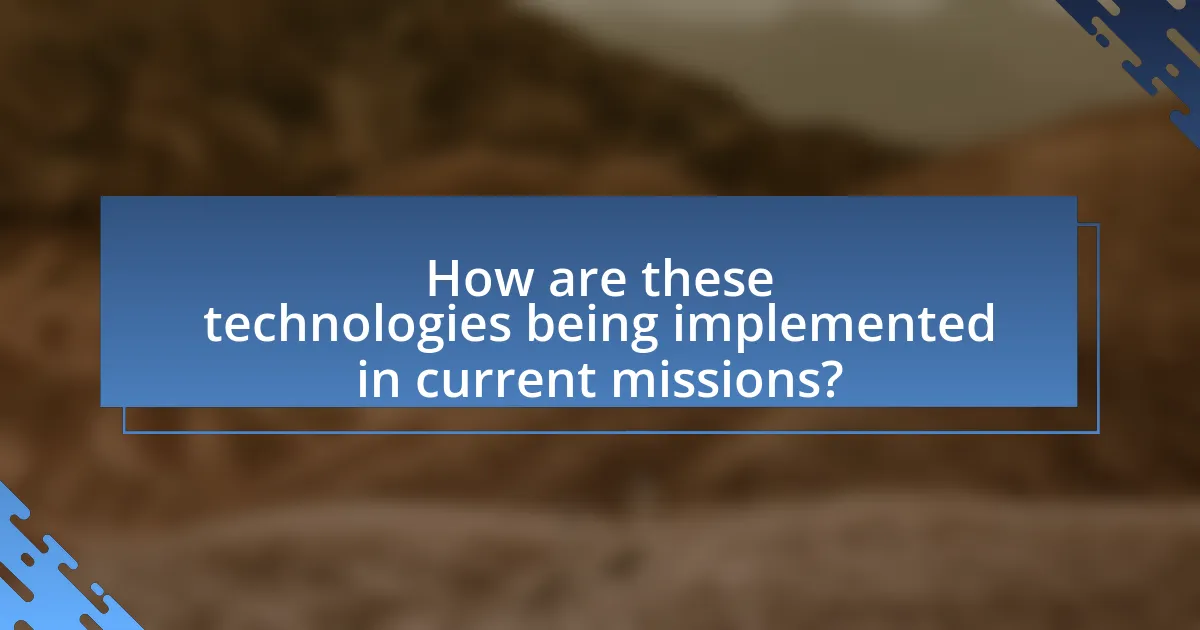
How are these technologies being implemented in current missions?
Innovative technologies are being implemented in current space missions through the integration of advanced robotics, artificial intelligence, and autonomous systems. For instance, NASA’s Perseverance rover utilizes AI for navigation and decision-making, enabling it to analyze Martian terrain and select optimal paths autonomously. Additionally, the European Space Agency’s Hera mission employs advanced robotics for asteroid exploration, demonstrating the application of these technologies in real-time data collection and analysis. These implementations enhance mission efficiency and safety, as evidenced by the successful deployment of autonomous drones in lunar missions, which facilitate detailed surface mapping and resource identification.
What examples of recent missions showcase innovative technologies?
Recent missions that showcase innovative technologies include NASA’s Perseverance rover, which utilizes advanced autonomous navigation and AI for terrain analysis on Mars, and the European Space Agency’s JUICE mission, which employs cutting-edge propulsion systems and instruments to explore Jupiter’s moons. These missions exemplify the integration of state-of-the-art technologies, such as Perseverance’s use of the MOXIE experiment to produce oxygen from Martian CO2, and JUICE’s ability to conduct detailed studies of icy worlds, demonstrating significant advancements in space exploration capabilities.
How have these technologies improved mission outcomes?
Innovative technologies have significantly improved mission outcomes by enhancing data collection, analysis, and operational efficiency in space missions. For instance, advancements in satellite imaging and remote sensing technologies have increased the accuracy of environmental monitoring, enabling timely responses to natural disasters. Additionally, the integration of artificial intelligence in mission planning and execution has streamlined processes, reducing operational costs by up to 30% and increasing mission success rates. Furthermore, the development of reusable launch systems has lowered the cost of access to space, allowing for more frequent missions and greater scientific exploration. These improvements are evidenced by successful missions such as NASA’s Mars Perseverance Rover, which utilized cutting-edge technologies to achieve its objectives efficiently.
What lessons have been learned from these implementations?
The lessons learned from the implementations of innovative technologies in next-generation space missions include the importance of adaptability, the necessity for robust testing protocols, and the value of interdisciplinary collaboration. Adaptability has proven crucial as technologies must evolve to meet unforeseen challenges during missions, exemplified by the adjustments made during the Mars rover missions. Robust testing protocols are essential to ensure reliability, as demonstrated by the failures and subsequent redesigns of various spacecraft components. Interdisciplinary collaboration has shown to enhance problem-solving capabilities, as seen in projects like the International Space Station, where diverse expertise leads to innovative solutions. These lessons underscore the need for a flexible, well-tested, and collaborative approach in future space endeavors.
What future missions are planned that will utilize these technologies?
Future missions planned to utilize innovative technologies include NASA’s Artemis program, which aims to return humans to the Moon by 2024, leveraging advanced propulsion systems and autonomous landing technologies. Additionally, the European Space Agency’s Jupiter Icy Moons Explorer (JUICE) mission, set for launch in 2023, will employ cutting-edge instruments for studying the icy moons of Jupiter, utilizing enhanced communication technologies for data transmission. These missions exemplify the integration of new technologies to achieve ambitious exploration goals, as evidenced by their reliance on advancements in robotics, AI, and propulsion systems.
How are agencies preparing for the integration of new technologies?
Agencies are preparing for the integration of new technologies by investing in research and development, enhancing workforce training, and establishing partnerships with tech companies. For instance, NASA has allocated significant funding towards developing advanced propulsion systems and autonomous systems to improve mission efficiency. Additionally, agencies are implementing training programs to equip their personnel with the necessary skills to operate and maintain these new technologies, ensuring a smooth transition. Collaborations with private sector innovators, such as SpaceX and Blue Origin, further facilitate the adoption of cutting-edge technologies, enabling agencies to leverage external expertise and accelerate their technological advancements.
What are the anticipated challenges for upcoming missions?
Anticipated challenges for upcoming missions include technological limitations, budget constraints, and environmental factors. Technological limitations may arise from the need for advanced propulsion systems and reliable life support technologies, which are critical for long-duration missions. Budget constraints can hinder the development and deployment of innovative technologies, as seen in previous missions where funding shortfalls delayed timelines. Environmental factors, such as radiation exposure and microgravity effects on human health, pose significant risks that require comprehensive mitigation strategies. These challenges are well-documented in space mission planning literature, highlighting the need for robust solutions to ensure mission success.
What best practices should be followed when adopting innovative technologies in space missions?
When adopting innovative technologies in space missions, organizations should prioritize thorough testing and validation of new systems to ensure reliability and safety. This practice is essential because space missions often involve high-stakes environments where failures can lead to significant financial loss and mission failure. For instance, NASA’s Mars Rover missions have demonstrated the importance of rigorous testing protocols, as each rover underwent extensive simulations and tests to validate its systems before launch. Additionally, fostering collaboration between interdisciplinary teams enhances the integration of diverse expertise, which is crucial for addressing complex challenges in space technology. This approach has been effectively utilized in projects like the International Space Station, where collaboration among various space agencies has led to successful technology adoption and mission execution. Lastly, maintaining flexibility in project management allows for iterative improvements and adaptations as new technologies emerge, as seen in the ongoing developments in satellite technology and propulsion systems.
